Tightening belts. US Marine Corps Projects Have Foggy Prospects
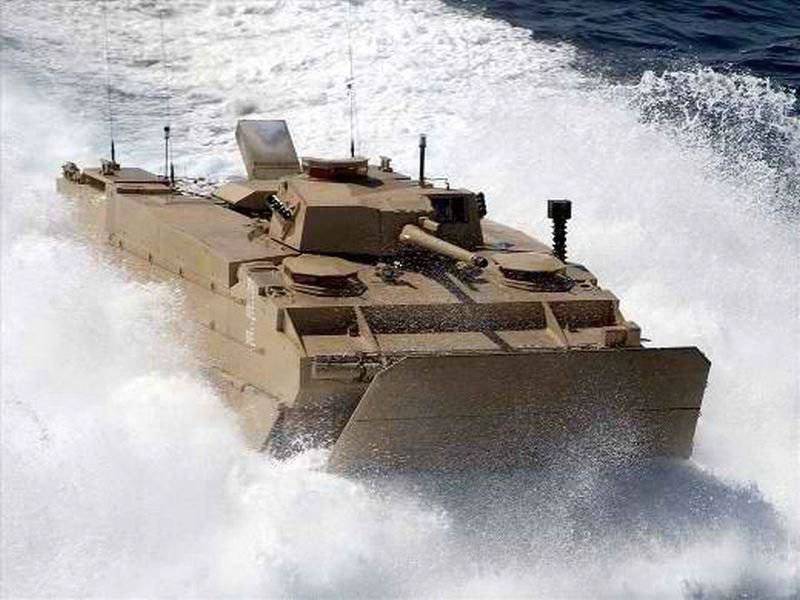
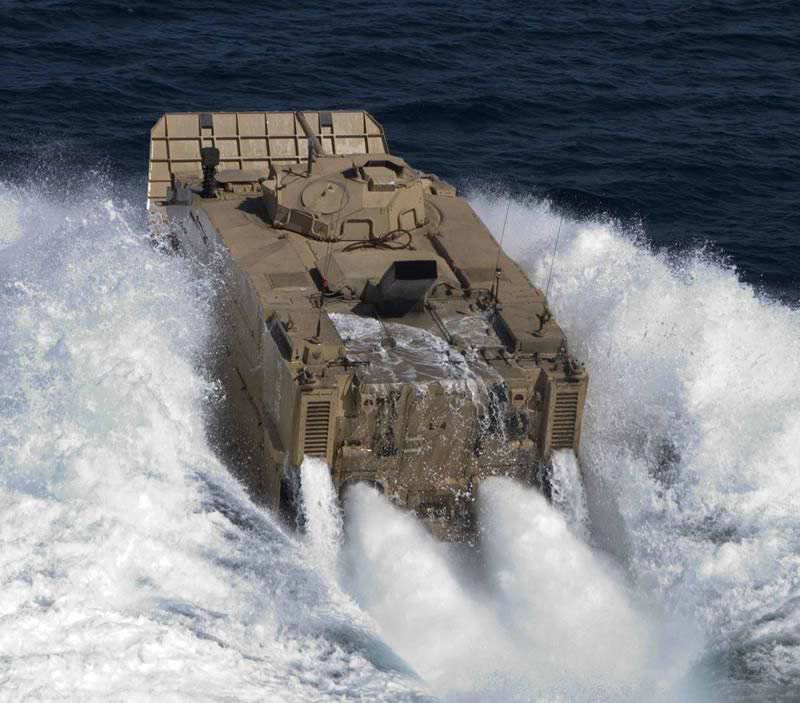
The original EFV prototypes were found to be unreliable after testing in 2006. In January, the Pentagon approved 2009 for further refinement by the General Dynamics contractor and issued a permit for the manufacture and testing of new prototypes. However, for financial reasons, the EFV project in 2011 was canceled
The Marine Corps' plan to create promising airborne forces, which should become “crisis response forces”, was once again in the air, since funding for all projects was reduced.
The main model of the US Marine Corps (USCM) in the future will shift from ground operations and counterinsurgency tactics in Iraq and Afghanistan over the past decade to the so-called “crisis response forces” of the United States. In part, this entails a search for easier solutions for various military equipment so that, at the right moment, the infantrymen can again focus on deploying from the US Navy ships.
The Marines have many deployment methods in their arsenal and still purchase the MV-22 Osprey convertiplane for fast and long-range expeditionary tasks. However, during landing operations that require infantry maneuvering from ship to shore, the USMC still relies on amphibious assault vehicle (AAV) 70 assault vehicles, which it has been trying to replace for quite a long time.
In 2011, the Expeditionary Fighting Vehicle (EFV) expeditionary combat vehicle program, which was supposed to replace the obsolete AAV, was closed after about 3 billions of dollars were spent on development and several prototypes were made.
Pentagon officials estimate that 12 billions more is needed to refine and purchase this machine. At that time, this figure led the Pentagon chief, Robert Gates, and the command of the US KMP to conclude that the new floating machine was simply too expensive.
After this, the corps took advantage of the open budget framework and extended the deadlines to create a three-pronged approach for its portfolio of floating machines. First, an average modernization of a part of the AAV fleet will be carried out in order to maintain combat capabilities until the next generation machine appears; second, an amphibious combat vehicle (ACV) floating combat vehicle will be developed as a replacement for the previous EFV; and finally, third, the deployment of the fleet of Marine Personnel Carrier (MPC) 579 fleet of new marine armored personnel carriers will be accelerated, which will complement the fleet of ACVs.
At present, even this reserve plan has undergone a significant audit due to increasingly unclear financial prospects.
In March 2013 of the year, an “audit” of budget items was carried out, according to which defense spending could be cut by a total of 500 billion dollars to 2021, if Congress and the White House did not agree on a budget agreement and change the regulations. At the moment, there is little agreement between Democrats and Republicans and budget cuts can be realized. In this regard, the US KMP has reduced its appetites for plans for the purchase of equipment.
“The MPC project is currently off the agenda,” US Commander General James Amos Commander in June 2013 told reporters.
"You can not act on the principle of" Since this was not a very good idea, then the need for it immediately disappears. " But, you can not have everything at once. Therefore, we made a decision regarding the MPC project, maybe we will keep the project afloat, but ... we are not directing our forces to implement the MPC project at this time. "
A corps spokesman, Manny Pacheco, said that the infantry had tested four proposed platforms in order to assess the buoyancy, survivability and "human factors." For example, the number of people accommodated in the car (the requirements say nine infantrymen and two crew members) and how to pack equipment.
He reported that all four machines performed well in all aspects of the tests, including explosive tests in the Nevada test center.
Pacheco remarked that the tests demonstrated “four workable machines” and therefore the ILC is sure that if, ultimately, the MPC project returns, then it can be relatively easily advanced. In October, the government sent test reports to each of the manufacturers.
In August, 2012, the USCM issued four contracts worth about 3,5 million dollars to each of the teams led by BAE Systems, General Dynamics Land Systems (GDLS), Lockheed Martin, and SAIC.
Lockheed Martin together with Finnish Patria Land Systems introduced the Havoc 8x8 car, which is based on the AMV (Armored Modular Vehicle) Patria; currently it is in service with several European countries.
BAE Systems and Iveco jointly presented a variant of the wheeled vehicle SuperAV 8x8 developed by an Italian company; SAIC together with Singaporean ST Kinetics introduced a platform based on the Terrex 8x8 armored personnel carrier, which is in service with the Singapore army.
GDLS was particularly laconic about its proposal and even denied its participation in the program until the middle of 2013. In June, the company issued a statement saying that its proposal was based on the LAV III family of machines and included a double V-shaped hull (DVH). GDLS manufactures these enclosures with enhanced protection for wheeled vehicles of the American Stryker exchange program.
The MPC was supposed to have levels of protection comparable to those of an MRAP class machine (with increased protection against mines and improvised explosive devices) and weigh about 20-25 tons. The reinforced rifle squad should be placed in two MPC vehicles, that is, an MPC company could, in this case, transfer an infantry battalion with the participation of its regular wheeled vehicles. These machines, although not floating, should, nevertheless, force rivers, waterways and overcome light surf, since it is assumed that after unloading from a landing craft they will act on the coast near the landing site.
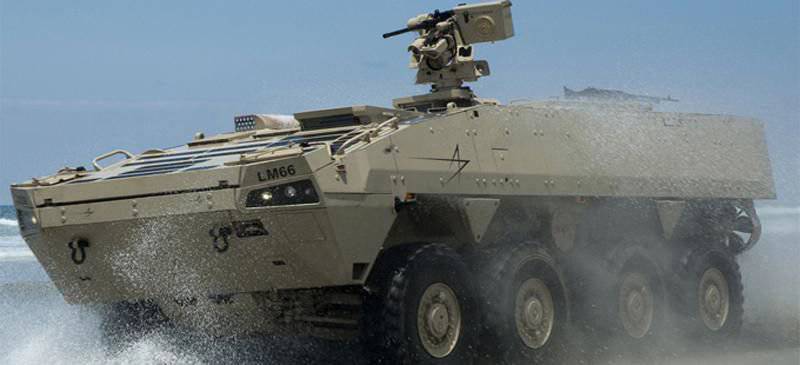
Patria Land Systems and Lockheed Martin have teamed up under the MPC program (currently suspended indefinitely) and presented the AMV with the remotely controlled Kongsberg Protector combat module.
Amphibious Combat Vehicle Floating Combat Vehicle
While the MPC project within the framework of long-term plans to re-equip the USMC is suspended indefinitely, officials have high hopes for the deployment of a new floating machine under the ACV program.
However, the infantrymen are very careful in implementing the ACV program, as they fear the collapse of the second project already, which may mean the elimination of common needs. To this end, various studies were conducted in which all possible replacements of delivery vehicles from ship to shore were studied.
An analysis of the alternatives was completed in June 2012 by the Department of Defense with the active participation of the Navy and the United States Commission. In this analysis, several options were considered, including the transportation of land vehicles to the shore by means such as, for example, an amphibious assault ship, instead of using a floating machine.
General Amos said that the analysis of alternative options "confirmed the need for a floating machine ... some kind of surface capabilities that you could use ... in a combat environment for landing troops with combat."
However, in this analysis, the speed on the water was not considered, and this became the main factor determining the cost of the EFV car, which had to “plan” on the water and thereby reach speeds up to 28 nodes.
In the fall of 2013, the USCM conducted a final study of the possible speeds of the ACV machine's float, which allowed to confirm which characteristics are feasible from a technological and financial point of view.
“I made a request to the industry and asked her to go back, using all that was left of the EFV project and all the existing experience in manufacturing current machines, and tell us what are our best suggestions regarding the ability to make the planned machine. They are going to come back to me this fall and then we will decide on the ACV car, ”General Amos said in June 2013.
“They will inform me about this in the fall, and immediately after the new 2014 of the year we will issue a request for proposals,” he said.
After the review is complete, the ICP “will find out exactly what the requirements are, and the order of how much it can cost. Cost is variable for me in this case, ”added General Amos.
During the early stages of the ACV program planning, the infantrymen expected to buy 573 platforms at the price of 12 million dollars apiece. At the same time, the platform should have a mass of approximately 31 751 kg and develop at sea speed up to 8 nodes with a cruising range of about 12 miles (22 km) from the coastline.
In May, 2013, the deputy commander for combat development, General Richard Mills, said that perhaps the maximum speed on the water of the ACV machine "will exceed 15 nodes", of course, if it is decided to go in that direction.
"This has several advantages: less time in the water ... accelerated movement from ship to shore, the ability of ships to move away at sea to avoid threats from the shore," he said in the Navy subcommittee of the Senate Defense Committee.
“It also gives you the range and the ability to pass by enemy defenses and enemy coasts where you do not want to land,” General Mills expressed his opinion on a faster option. “The increase in comparison with current opportunities is simply huge.”
General Amos said that the US KMP will make decisions on these requirements after the industry reports on the cost and reaching a compromise between the carrying capacity and the speed of the platforms on the water. “We will take the decision as a basis right at the beginning of 2014 of the year and say,“ well, we are going to have a displacement type machine or a machine with a high speed of fusion, ”he added.
The machine displacement type moves on the water surface, but can not go on the deck (planed) and, therefore, its speed is limited by mass or displacement. Outdated AAV Marine Corps are considered displacement type machines.
Honored Veteran AAV
Nearly AN (Amphibious Assault Vehicle) Marine Corps 400 can be upgraded or maintained, which will undoubtedly increase their capabilities and survivability.
According to Pacheco, “at least four players are doing research and development to determine what can be done to extend the life of deserved machines.”
He said that the Marine Corps issued a request for information in order to understand what can be done, since the upgrade cannot be limited to only better armor and seats, since any added mass can affect the buoyancy and theoretically require a new suspension, track, transmission etc. However, the current engine is relatively powerful and its replacement is optional.
The power unit based on the Cummins VT400 diesel engine was installed on machines in 80-ies during their modernization to the current version of AAV7A1.
The next step of the ILC on the AAV program will be the issue of a request for proposals, which is scheduled to be published at the end of 2014.
The AAV vehicle entered service in the 1972 year and is still the main armored personnel carrier for the Marines. While the infantrymen are waiting for their new floating tractor, the AAV vehicle must remain in service at least until 2030.
To extend the life of the AAV7Al variant, the USCM is considering plans to upgrade the 392 vehicles in the BTR version, along with a possible upgrade of the commander and evacuation options. New survivability technologies will be integrated into the machine, weight will be optimized, buoyancy will be improved and combat stability will be improved.
According to the “Investment Plan for Modern Technologies [ATIP] 2013”, the United States International Law-Making Commission would like to see “technologies that provide advantages in ceramics and multi-layered reservations” in order to increase survivability while maintaining mass. The document states that decisions on survivability are likely to require “internal and external bottom reservations,” as well as anti-explosion seats and splinterproof pads.
As for the mass, the ATIP notes that increasing the survivability of the machine will probably also increase its mass. In this regard, the infantrymen say that they have a "critical need" for light materials and "improving the design to increase buoyancy and protect it." The Marine Corps is also in search of technologies that "increase reliability and reduce operating costs and maintenance costs."
While the program is still to be formally accepted, several investment opportunities were identified in the ATIP (some of which are currently being funded) related to the modernization of AAV. This upgrade includes: a modular lightweight booking system, a car adaptation project from the Advanced Research Department DARPA, self-engaging fuel tanks, an active laser protection system, a modern transmission, lightweight modular external fuel tanks, emergency escape capability, high-strength / high-viscosity nanocomposition materials, extended track life, etc.
At 2014 fiscal year, the USCM requested funds for upgrades. At the same time, the beginning of the design and development stage is expected, within which six prototypes will be manufactured.
Prototype testing is scheduled for the end of 2015, and production will start at the end of next year. If everything goes according to plan, then the upgraded AAV vehicles will start coming into service at the end of the 2018 of the fiscal year, and their full combat readiness is expected no earlier than 2022 of the year.
As for the current modernization, in the short term, the program to improve AAV will require doubling the original budget. In order to continue purchasing components and modernizing the fleet of these machines, 2014 million dollars were requested for the 32,4 year. For example, new intercom systems will be procured to replace outdated VIC-II systems, on-board computers and software for them, throttle control levers and throttle control systems will be refined and the emergency exit lighting will be installed.
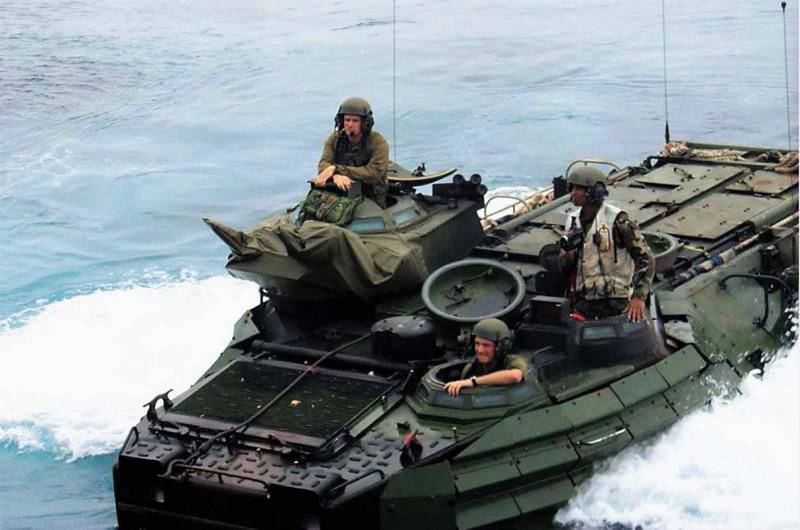
The US KMP considers as its highest priority not only the replacement of the fleet of obsolete AAV machines, but also the program for extending the life of these floating "veterans"
Joint Light Tactical Vehicle Project
In order to increase its capabilities regarding the protected maneuver on land, the USMC plans to buy 5500 new Joint Light Tactical Vehicles (JLTV) light tactical vehicles as a replacement for their HMMWV jeeps, which are no longer used outside military bases in theaters due to their vulnerability to roadside bombs directional action).
However, for a long time, the infantrymen did not dare to buy a larger, heavier and potentially more expensive car, as they strive to restore their expeditionary capabilities.
The former KMP commander, James Conway, often expressed concern that the heavier platform would not be able to meet the basic requirements of the infantry, and he pointed out the need to purchase a lighter vehicle that could be transported inside the helicopter or on its suspension. One day, Conway said that the hull would not buy cars if they weigh 20 000 pounds (9070 kg).
Mass issues, in general, have been resolved, the proposed JLTV machines can be transported in a helicopter or on its suspension. The White House 2012 Defense Leadership emphasizes that funding for JLTV should be protected, but the US KMP commanders spoke about ongoing budgetary problems, which indicates a change in the priority of this program.
“I’m telling everyone that you have to lower the cost, and I’m not going to buy it,” General Amos said in June. “Given all the abbreviations, I would say that this is a subject for consideration.”
The initial cost of JLTV was planned at about 300 000 dollars before installing protection and functional kits, but then the program changed the requirements in order to get the average manufacturing cost per unit below 250 000 dollars (in 2011 prices of the year) across the entire machine family. The average purchase price should be significantly higher, since the program also needs to take into account the cost of new equipment for training, deployment of machines, spare parts, various kits and other systems.
A representative of the corps explained in July 2013 of the year that the entire JLTV program, given the development and production, is expected to cost approximately 30 billion dollars (in 2012 prices of the year).
In the next 20-25 years, the US Army plans to buy approximately 49 000 JLTV vehicles, but the marines are counting on completing purchases of these vehicles by the 2022 year, because by that time their budget will be focused on purchasing ACV machines. If budget cuts remain unchanged and financial problems arise, the hull will not give up the floating conveyor for the sake of a new car.
“We need them, I like them, but if I go through full sequestering on 10% [of the planned annual budgets], then I doubt if I can afford JLTV,” said General Amos. “I will take my HMMWV armored cars, send them to the factory, to the workshop and get my seven-ton trucks before the ACV project is launched.”
In August, 2012 was awarded contracts to teams led by AM General, Lockheed Martin and Oshkosh for the current development and deployment phase (EMD) of the JLTV program. In August, 2013 of the year, each of them presented a prototype 22 for the test period, including an assessment of the technical characteristics, reliability and survivability, the 14 months duration, which began in September of the 2013 year.
Programmatic changes at the EMD stage may occur, but JLTV project leader Colonel John Cavedo believes that any changes in requirements will be "minimal." Cavedo hopes that the final endorsement of the requirements for JLTV will take place at the end of 2014 or the beginning of 2015. Also, the Pentagon program is scheduled for 2015 year, and the publication of the final request for proposals and the selection of only one contractor.
Meanwhile, the US KMP plans to launch the so-called Life Exposure Initiative (SMI), which means extending the life to 2030 of the year around 13 000 of HMMWV vehicles. According to this plan, the marine fleet of 24 000 HMMWV armored vehicles will be reduced to about 18 500 units and eventually 5500 of them will be replaced with new JLTV. According to the ATIP Investment Plan, in the framework of SMI, it is planned to “restore the capabilities of the existing ECV version of the HMMWV car regarding safety, performance and reliability.”
ECV is the latest version of the HMMWV, which should remain in service. In accordance with current plans, only some components related to safety, performance and mobility will be updated. The list of components contributing to increased survivability for the ECV variant was determined later, at the end of 2013.
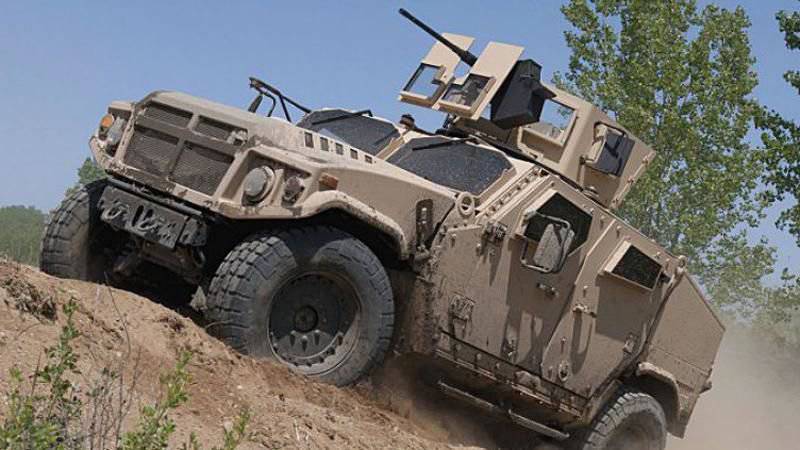
AM General with its project BRV-0 has joined its competitors Lockheed Martin and Oshkosh in the next phase of the development of the JLTV car
Unanswered questions
Since the political establishment in Washington is not able to get out of the two-year budget impasse, the USMC and other types of troops are beginning to prepare for a future in which the sequestration continues to cover defense budgets and forces the military to further reduce their numbers and their purchases.
The cuts in planned budgets, which are a consequence of the Pentagon’s decision to reduce their future requests for 487 million dollars in advance, forced the marines to reduce the final strength of active-duty personnel from the current 194 000 to 182 000 people.
General Amos in June 2013 suggested that if sequestration continued, the corps “would have to cut another 8000 man,” which means bringing the final number to 174 000 infantry. The corps has 27 regular infantry battalions (the number of battalions is approximately 800-1000 infantry), therefore, these reductions will reduce the number of battalions to 23.
As General Amos explained, the reserve component of the US KMP will remain at the level of 39 600 people, since in the past decade the number of reserves did not grow, unlike the number of the rest of the corps.
Pentagon officials at the end of July revealed recommendations from a secret analysis of the SCMR's strategic alternatives, which explored a wide range of future budget opportunities. According to him, the body in the most dramatic scenarios, for the most part, will remain as it is.
However, if 10 years of sequestering are taken into account, then according to the most likely scenario proposed in SCMR, the number of US KMPs will decrease from 182 000 people to about 150 000 – 175 000 people.
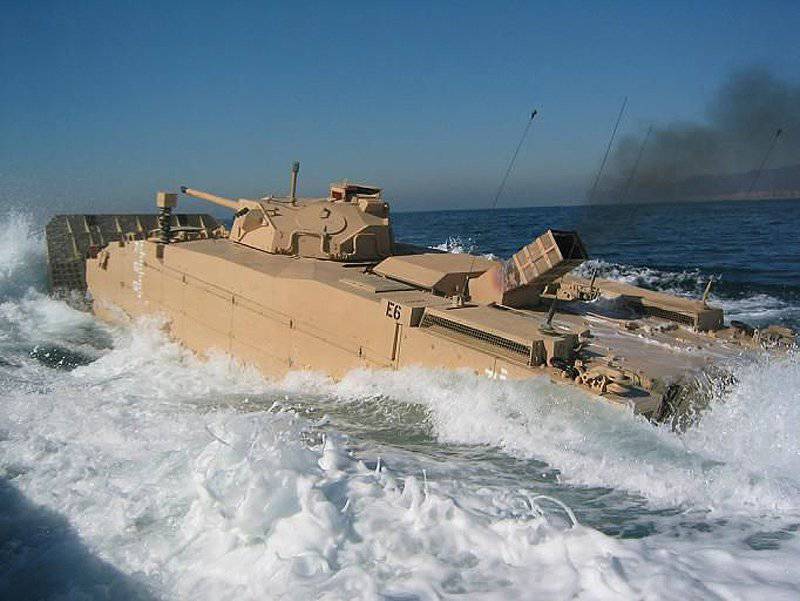
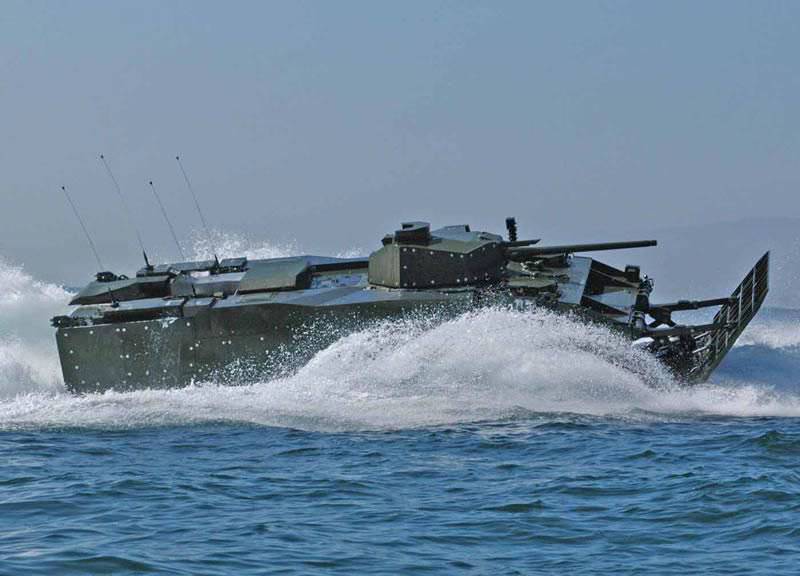
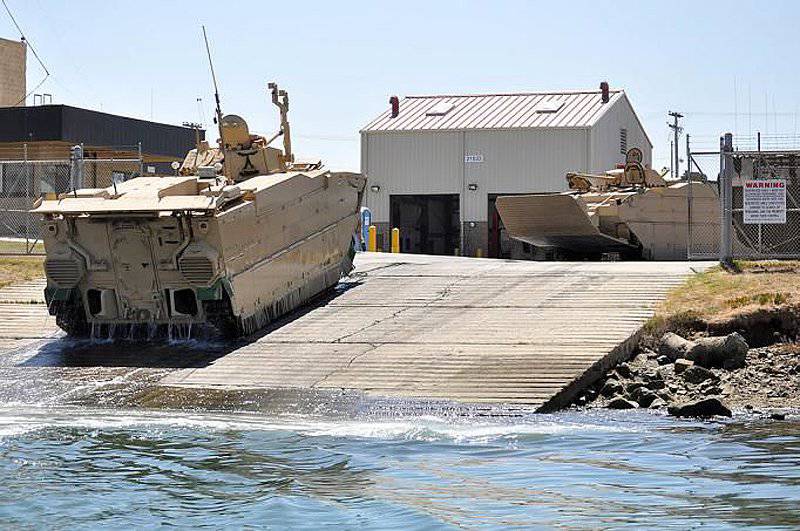
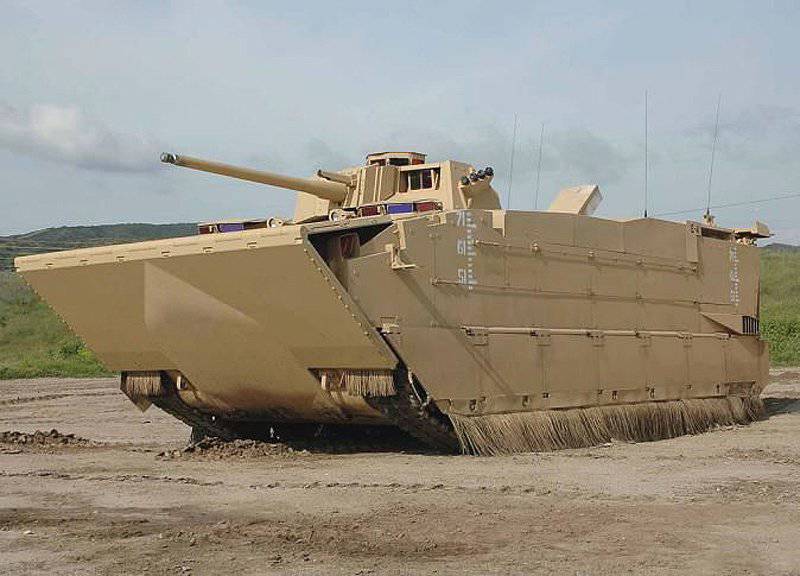
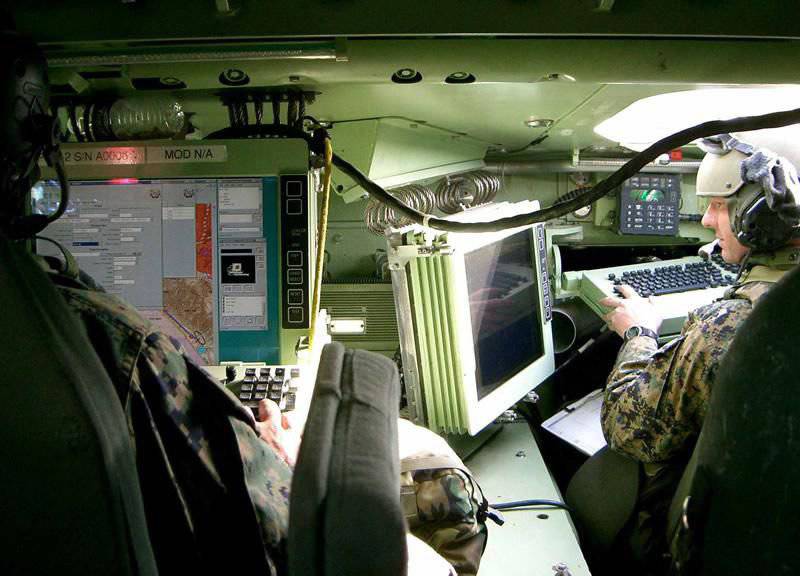
EFV project "dead in the Bose"
Materials used:
www.janes.com
www.marines.mil
www.baesystems.com
www.generaldynamics.com
www.lockheedmartin.com
Information